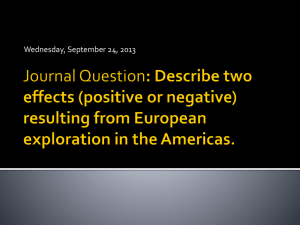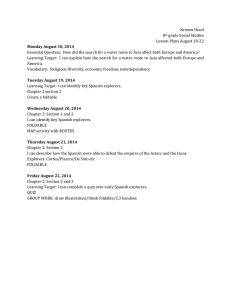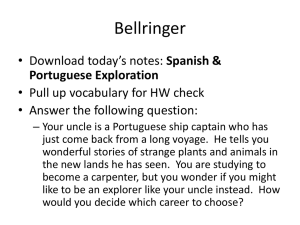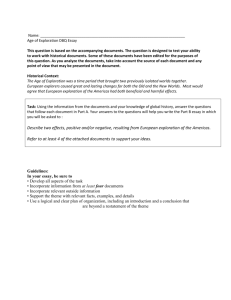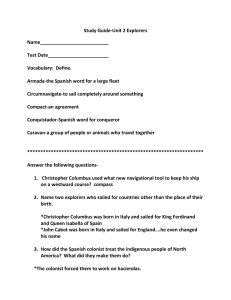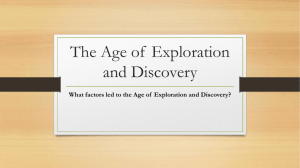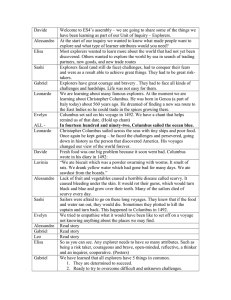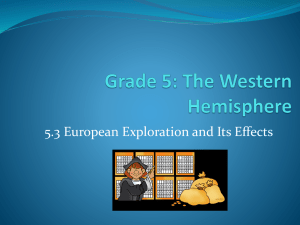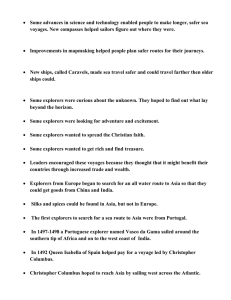View Teacher's Guide PDF (F.P.O.)
advertisement
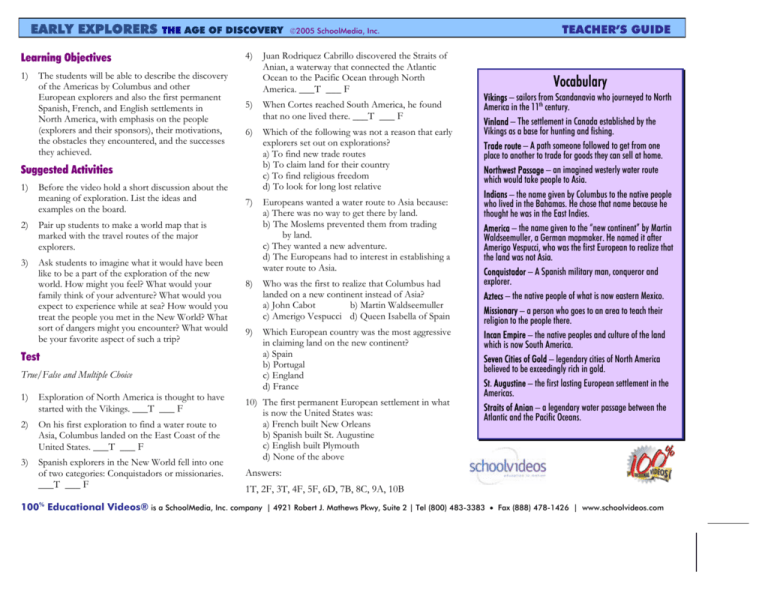
EARLY EXPLORERS THE AGE OF DISCOVERY Learning Objectives 1) The students will be able to describe the discovery of the Americas by Columbus and other European explorers and also the first permanent Spanish, French, and English settlements in North America, with emphasis on the people (explorers and their sponsors), their motivations, the obstacles they encountered, and the successes they achieved. 4) Before the video hold a short discussion about the meaning of exploration. List the ideas and examples on the board. 2) Pair up students to make a world map that is marked with the travel routes of the major explorers. 3) Ask students to imagine what it would have been like to be a part of the exploration of the new world. How might you feel? What would your family think of your adventure? What would you expect to experience while at sea? How would you treat the people you met in the New World? What sort of dangers might you encounter? What would be your favorite aspect of such a trip? When Cortes reached South America, he found that no one lived there. ___T ___ F 6) Which of the following was not a reason that early explorers set out on explorations? a) To find new trade routes b) To claim land for their country c) To find religious freedom d) To look for long lost relative 7) Europeans wanted a water route to Asia because: a) There was no way to get there by land. b) The Moslems prevented them from trading by land. c) They wanted a new adventure. d) The Europeans had to interest in establishing a water route to Asia. 8) Who was the first to realize that Columbus had landed on a new continent instead of Asia? a) John Cabot b) Martin Waldseemuller c) Amerigo Vespucci d) Queen Isabella of Spain 9) Which European country was the most aggressive in claiming land on the new continent? a) Spain b) Portugal c) England d) France Test True/False and Multiple Choice 1) Exploration of North America is thought to have started with the Vikings. ___T ___ F 2) On his first exploration to find a water route to Asia, Columbus landed on the East Coast of the United States. ___T ___ F 3) Spanish explorers in the New World fell into one of two categories: Conquistadors or missionaries. ___T ___ F Juan Rodriquez Cabrillo discovered the Straits of Anian, a waterway that connected the Atlantic Ocean to the Pacific Ocean through North America. ___T ___ F 5) Suggested Activities 1) ©2005 SchoolMedia, Inc. 10) The first permanent European settlement in what is now the United States was: a) French built New Orleans b) Spanish built St. Augustine c) English built Plymouth d) None of the above TEACHER’S GUIDE Vocabulary Vikings – sailors from Scandanavia who journeyed to North America in the 11th century. Vinland – The settlement in Canada established by the Vikings as a base for hunting and fishing. Trade route – A path someone followed to get from one place to another to trade for goods they can sell at home. Northwest Passage – an imagined westerly water route which would take people to Asia. Indians – the name given by Columbus to the native people who lived in the Bahamas. He chose that name because he thought he was in the East Indies. America – the name given to the “new continent” by Martin Waldseemuller, a German mapmaker. He named it after Amerigo Vespucci, who was the first European to realize that the land was not Asia. Conquistador – A Spanish military man, conqueror and explorer. Aztecs – the native people of what is now eastern Mexico. Missionary – a person who goes to an area to teach their religion to the people there. Incan Empire – the native peoples and culture of the land which is now South America. Seven Cities of Gold – legendary cities of North America believed to be exceedingly rich in gold. St. Augustine – the first lasting European settlement in the Americas. Straits of Anian – a legendary water passage between the Atlantic and the Pacific Oceans. Answers: 1T, 2F, 3T, 4F, 5F, 6D, 7B, 8C, 9A, 10B 100% Educational Videos® is a SchoolMedia, Inc. company | 4921 Robert J. Mathews Pkwy, Suite 2 | Tel (800) 483-3383 • Fax (888) 478-1426 | www.schoolvideos.com

